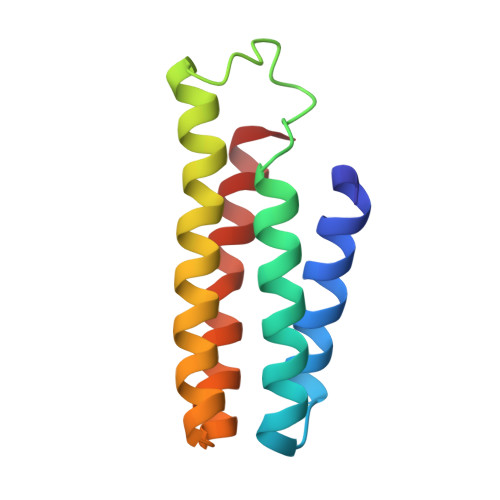Design of a Flexible, Zn-Selective Protein Scaffold that Displays Anti-Irving-Williams Behavior.
Choi, T.S., Tezcan, F.A.(2022) J Am Chem Soc 144: 18090-18100
- PubMed: 36154053
- DOI: https://doi.org/10.1021/jacs.2c08050
- Primary Citation of Related Structures:
8DRD, 8DRF, 8DRJ, 8DRL, 8DRM - PubMed Abstract:
Selective metal binding is a key requirement not only for the functions of natural metalloproteins but also for the potential applications of artificial metalloproteins in heterogeneous environments such as cells and environmental samples. The selection of transition-metal ions through protein design can, in principle, be achieved through the appropriate choice and the precise positioning of amino acids that comprise the primary metal coordination sphere. However, this task is made difficult by the intrinsic flexibility of proteins and the fact that protein design approaches generally lack the sub-Å precision required for the steric selection of metal ions. We recently introduced a flexible/probabilistic protein design strategy (MASCoT) that allows metal ions to search for optimal coordination geometry within a flexible, yet covalently constrained dimer interface. In an earlier proof-of-principle study, we used MASCoT to generate an artificial metalloprotein dimer, (AB) 2 , which selectively bound Co II and Ni II over Cu II (as well as other first-row transition-metal ions) through the imposition of a rigid octahedral coordination geometry, thus countering the Irving-Williams trend. In this study, we set out to redesign (AB) 2 to examine the applicability of MASCoT to the selective binding of other metal ions. We report here the design and characterization of a new flexible protein dimer, B 2 , which displays Zn II selectivity over all other tested metal ions including Cu II both in vitro and in cellulo . Selective, anti-Irving-Williams Zn II binding by B 2 is achieved through the formation of a unique trinuclear Zn coordination motif in which His and Glu residues are rigidly placed in a tetrahedral geometry. These results highlight the utility of protein flexibility in the design and discovery of selective binding motifs.
- Department of Chemistry and Biochemistry, University of California, San Diego, 9500 Gilman Drive, La Jolla, California 92093 United States.
Organizational Affiliation:


















